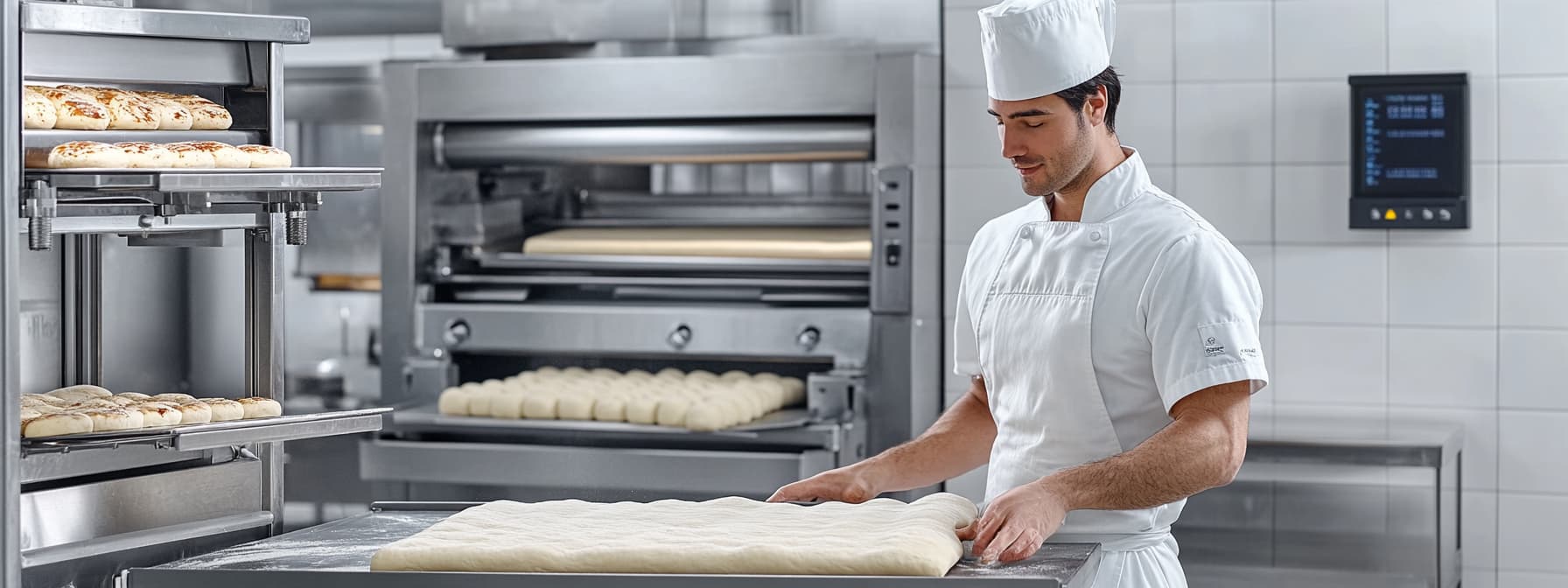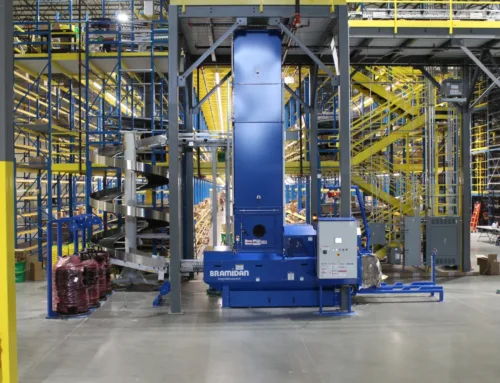
Are you struggling with inconsistent dough thickness in your bakery? Using a dough sheeter can transform your baking process, providing uniform results and saving valuable time. In this article, I will discuss the essential role of dough sheeters in bakeries, explore their numerous benefits, and guide you in choosing the right machine for your operation. By streamlining your bakery with the right dough sheeter, you can enhance product quality and boost efficiency, addressing common pain points faced by bakery owners.
Understand the Role of Dough Sheeters in Bakeries

A dough sheeter is an essential tool in a bakery that efficiently flattens and stretches dough with precision. It significantly enhances bakery operations by reducing manual labor and ensuring uniform thickness, contributing to consistent results in gluten development. I will discuss how this equipment not only streamlines your baking process but also complements other tools like convection ovens and display coolers and merchandisers from end2end logix, ultimately improving productivity and product quality.
What Is a Dough Sheeter?
A dough sheeter is a vital piece of equipment in any bakery, designed to efficiently flatten and stretch pastry dough with precision. This machine saves time and labor by creating consistent thickness, which is crucial for proper gluten development and uniform baking results. In my experience, using a dough sheeter alongside a mixer and other baking tools can significantly enhance the overall productivity and quality of baked goods.
- A dough sheeter helps achieve uniform thickness for pastries.
- This equipment reduces manual labor and saves time in the baking process.
- When used with a mixer, it improves overall dough consistency.
- Investing in a dough sheeter can enhance product quality and streamline operations.
How Does a Dough Sheeter Contribute to Bakery Efficiency?
In my experience, a dough sheeter plays a crucial role in enhancing bakery efficiency by streamlining the lamination process. Unlike traditional rolling pins, a dough sheeter provides consistent thickness, which directly impacts productivity and ensures uniform baking results. Using stainless steel components not only guarantees durability but also simplifies cleaning and maintenance, allowing for a more effective proofing process. This investment not only minimizes the time spent on dough preparation but also improves the quality of the final products, making it an essential asset for any bakery looking to optimize operations.
Dough sheeters streamline the process, saving time and effort in every bakery. Now, let’s look at how these machines can improve your craft and elevate your production.
Explore the Benefits of Using a Dough Sheeter Machine

Using a dough sheeter can significantly accelerate production time through efficient dough sheeting. It allows bakers to achieve consistent thickness, ensuring quality control across all products. Automation also reduces labor costs, making this bakery equipment an invaluable investment. I will explore these benefits further, shedding light on how efficient mixing, minimizing manual effort, and integrating refrigeration parts contribute to enhanced bakery operations.
Accelerate Production Time With Efficient Dough Sheeting
Efficient dough sheeting using a countertop dough sheeter machine can dramatically speed up production times in any bakery. With its ability to create perfectly uniform dough thickness, I’ve observed firsthand how bakers reduce their overall prep time while ensuring consistent quality across various products. Utilizing stainless steel components not only enhances durability but also simplifies maintenance, allowing for smoother operations and increased output. If you’re looking to elevate your baking process, feel free to contact us for insights on selecting the best dough sheeter tailored to your needs.
Achieve Consistent Thickness for Quality Control
Achieving consistent thickness is vital for quality control when working with puff pastry and laminated dough. Using a dough sheeter allows me to create uniform layers that ensure even baking in the oven, ultimately enhancing product appearance and texture. The precision offered by this machine eliminates variations that can arise from manual rolling, allowing for reliable results every time:
- Enhances the overall appearance and texture of baked goods.
- Reduces the risk of uneven baking, leading to better flavor development.
- Ensures optimal dough handling for consistent product quality.
Reduce Labor Costs Through Automation
Automating the dough sheeting process can significantly minimize labor costs in a bakery setting. By adopting this efficient equipment, I’ve noticed a marked reduction in the time my staff spends on manual dough preparation, allowing them to focus on other essential tasks. This not only streamlines workflow but also enhances productivity, making it a smart investment for any bakery aiming to optimize operations:
- Increased efficiency through reduced manual effort.
- Reallocation of staff to higher-value tasks within the bakery.
- Lower overall labor costs leading to better profit margins.
You now know how a dough sheeter can change your baking game. Let’s look at how to choose the right one for your bakery and make the best investment for your kitchen.
Choosing the Right Dough Sheeter for Your Bakery
Identifying the right dough sheeter for your bakery involves assessing key features that maximize efficiency, as well as considering your available space and production needs. In the following sections, I will outline important aspects to look for, such as machine specifications and capacity, to help you make an informed decision for streamlined operations and improved productivity.
Identify the Features That Maximize Efficiency
When selecting a dough sheeter for my bakery, I emphasize features that enhance efficiency and adaptability. Key aspects include the machine‘s width and thickness settings, which allow for various dough types and sizes, as well as its speed options that can match the bakery’s production demands. Investing in equipment with durable materials, such as stainless steel, also ensures longevity, reducing the frequency of maintenance interruptions:
- Adjustable width and thickness settings for versatile dough handling.
- Multiple speed options to align with production needs.
- Durable construction materials for long-term reliability.
Consider Your Space and Production Needs
When selecting a dough sheeter for my bakery, I always consider the available space and production needs. Measuring the footprint of the machine is essential to ensure it fits comfortably within the kitchen layout, allowing for easy movement and access to other equipment. Additionally, I assess my production volume to choose a machine with the right capacity and features that align with my baking output, ensuring that I can maximize efficiency without compromising quality:
- Measure kitchen space for proper placement of the dough sheeter.
- Evaluate production volume to determine machine capacity.
- Align machine features with operational workflow for efficiency.
You’ve found a good dough sheeter for your bakery. Now, let’s talk about how to use it effectively to get the best results.
Best Practices for Integrating a Dough Sheeter

Incorporating a dough sheeter into your bakery operations requires careful planning. I recommend prioritizing training for staff on proper dough sheeter operation to maximize efficiency and safety. Additionally, regular maintenance of the machine is crucial for optimal performance and longevity. These practices not only enhance workflow but also ensure consistent quality in your baked goods.
Incorporate Training for Staff on Dough Sheeter Operation
Incorporating training for staff on dough sheeter operation is critical for optimizing bakery performance. Through practical sessions, I guide team members in understanding the equipment‘s features, enabling them to achieve precise dough thickness and enhance production speed. Frequent training not only empowers staff with technical know-how but also fosters a culture of safety and efficiency within the workplace:
- Provide hands-on training sessions for new staff on equipment usage.
- Encourage ongoing education on maintenance and troubleshooting.
- Promote a culture of feedback and continuous improvement among team members.
Maintain Your Dough Sheeter for Optimal Performance
Maintaining your dough sheeter is essential for ensuring optimal performance and longevity. Regular cleaning of the stainless steel surfaces not only keeps the machine in good working condition but also helps prevent dough buildup, which can affect efficiency. Based on my experience, scheduling routine maintenance checks and promptly addressing any mechanical issues can save you time and money in the long run while keeping your bakery operations running smoothly.
Bakeries are not just places to make bread; they are stories of hard work and triumph. Let’s look at how some have thrived by embracing new tools and methods, reshaping their future.
Case Studies of Bakeries That Improved Efficiency
In this section, I will share success stories from bakeries that have integrated dough sheeters into their operations. We will look at a comparative analysis of production metrics before and after implementation, highlighting the tangible benefits of using this equipment. These insights will demonstrate the significant improvements in efficiency and quality that can be achieved with the right tools in place.
Success Stories of Bakeries Using Dough Sheeters
One bakery I worked with decided to integrate a dough sheeter into their operations, aiming to improve efficiency during the busy production hours. After implementing this equipment, they reported a 30% reduction in preparation time for laminated doughs, which allowed their bakers to focus more on creativity and product development. This transition not only boosted their production capabilities but also enhanced the consistency and quality of pastries, leading to better customer satisfaction:
- 30% reduction in preparation time for laminated doughs.
- Increased focus on creativity and product development.
- Enhanced consistency and quality of pastries.
- Improved customer satisfaction and sales.
Comparative Analysis of Production Before and After Implementation
After implementing a dough sheeter, bakeries typically experience significant changes in their production metrics. For instance, one bakery reported a marked increase in output, with production rates improving by 25% within just a few weeks. This improvement was attributed to reduced preparation times and enhanced consistency in dough quality that the sheeter provided, allowing bakers to focus on more complex tasks:
- 25% increase in overall production rates.
- Reduced preparation times that streamlined workflows.
- Improved dough consistency leading to better final products.
- Enhanced focus on creativity and product innovation.
As bakeries embrace new tools, questions arise about the changes they bring. Let’s address those common concerns about dough sheeters and what they truly mean for your operation.
Addressing Common Concerns About Dough Sheeters

When considering a dough sheeter, it’s important to weigh the initial investment against the long-term savings it can generate. Understanding maintenance costs and requirements also plays a crucial role in making an informed decision. I’ll explore these aspects further, demonstrating how a thoughtful approach to these concerns can enhance your bakery operations.
Initial Investment vs. Long-Term Savings
When weighing the initial investment of a dough sheeter against long-term savings, it’s essential to consider how this equipment can transform your bakery operations. I’ve seen firsthand how the upfront costs are offset by improved efficiency and reduced labor expenses. Over time, the consistent quality provided by a dough sheeter not only enhances customer satisfaction but also leads to increased sales, making it a worthwhile investment for bakeries aiming for growth.
Understanding Maintenance Costs and Requirements
Understanding the maintenance costs and requirements for a dough sheeter is key to ensuring its longevity and optimal performance in your bakery. Regular cleaning and scheduled maintenance checks can help prevent costly repairs and extend the lifespan of the machine. Based on my experience, investing a small amount of time and budget into proper upkeep can save you significant expenses in the long run, allowing your bakery to operate smoothly and efficiently:
- Prioritize routine cleaning to avoid dough buildup.
- Schedule regular maintenance checks to identify potential issues early.
- Educate staff on proper usage to reduce wear and tear.
Conclusion
Investing in a dough sheeter is pivotal for any bakery aiming to enhance efficiency and product quality. This equipment not only accelerates production times but also ensures uniform dough thickness, resulting in consistent baking results. By automating the dough sheeting process, bakeries can reduce labor costs and streamline operations, allowing staff to focus on higher-value tasks. Ultimately, a dough sheeter is an essential asset that elevates overall performance and customer satisfaction in commercial baking.
Share This Story, Choose Your Platform!
Get In Touch
Phone: (847) 722-6942
Email: sales@end2endlogix.com
Web: end2endlogix.com


